Creating Custom Multichannel Customer Engagement
Cegedim’s Hub Helps Sales Reps Simplify Complex Digital Mix
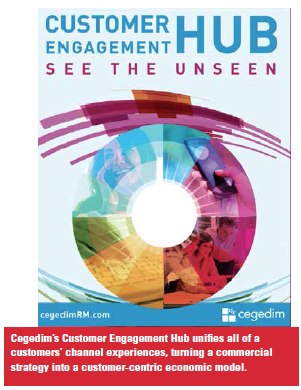 In these challenging times of shrinking prescriber access, pharmaceutical marketers need to determine a meaningful digital channel mix to engage their customers right out of the gate. Cegedim’s Customer Engagement Hub (CEH) takes big data complexity and turns it into concrete, useful insights across all channels by assigning a single customer identifier; providing a single customer profile; maintaining a common repository of interactions; delivering intelligence on customer behavior; and enabling campaign planning, alignment, and execution on intelligence. CEH links all channels together so marketers can tailor their channel mix according to customer needs. Currently, the platform is initially focused on HCPs’ professional development, but this technology can also be leveraged to integrate patients into that process, through better personalized communication, for more consistent and meaningful messages. By providing a mechanism for commercial teams to deliver the precise information the prescriber needs through the right channel engagement, CEH facilitates access to the information HCPs require at the precise moment it is needed.
In these challenging times of shrinking prescriber access, pharmaceutical marketers need to determine a meaningful digital channel mix to engage their customers right out of the gate. Cegedim’s Customer Engagement Hub (CEH) takes big data complexity and turns it into concrete, useful insights across all channels by assigning a single customer identifier; providing a single customer profile; maintaining a common repository of interactions; delivering intelligence on customer behavior; and enabling campaign planning, alignment, and execution on intelligence. CEH links all channels together so marketers can tailor their channel mix according to customer needs. Currently, the platform is initially focused on HCPs’ professional development, but this technology can also be leveraged to integrate patients into that process, through better personalized communication, for more consistent and meaningful messages. By providing a mechanism for commercial teams to deliver the precise information the prescriber needs through the right channel engagement, CEH facilitates access to the information HCPs require at the precise moment it is needed.
Multi-Payer, Multi-Pharmacy Collaborative
Pharmacy Quality Solutions’ New Platform Enables Payer/Pharmacy Collaboration
Pharmacy professionals, pharmacy organizations, and health and drug plans have a new platform to ensure 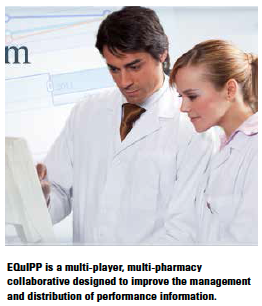 medication use quality improvement. EQuIPP — electronic quality improvement platform for plans and pharmacies — is the first national platform for pharmacy quality measurement, benchmarking, and feedback. The multi-payer, multi-pharmacy collaborative is designed to build alignment of health plans and pharmacies to enable the efficient management and distribution of performance information for key quality measures, such as those used in the Medicare Part D Star Ratings.
medication use quality improvement. EQuIPP — electronic quality improvement platform for plans and pharmacies — is the first national platform for pharmacy quality measurement, benchmarking, and feedback. The multi-payer, multi-pharmacy collaborative is designed to build alignment of health plans and pharmacies to enable the efficient management and distribution of performance information for key quality measures, such as those used in the Medicare Part D Star Ratings.
EQuIPP is operated by Pharmacy Quality Solutions, a joint venture partnership of Pharmacy Quality Alliance and CECity, and is being used by the nation’s leading chain and independent pharmacies and health plans.
The model fosters an environment in which payers can engage their pharmacy network in quality-centered incentive reimbursement programs.
EQuIPP dashboards provide both pharmacy and payer organizations with a monthly assessment of their current performance on the Star Ratings measures as well as trend reports and benchmarks for comparison. The benchmarks include the CMS-defined Star Ratings thresholds for each measure as well as the average score on each measure within each market area (e.g., state) for which the health plan has provided data.
The dashboards also provide a head-to-head comparison of the pharmacies within a payer’s pharmacy network so that the payer can easily assess the relative performance of each chain as well as independent pharmacies.
The Medicare Part D Star Ratings program has created financial accountability for health plan sponsors for quality measures that are directly related to the services provided by community pharmacy organizations. Too often in healthcare settings, fragmented and burdensome quality reporting processes inhibit progress towards meaningful quality improvement efforts.
A common understanding of performance assessments among stakeholders will allow the system to move from measurement to improvement more quickly.
EQuIPP aligns the interests of several stakeholders, all with a focus on promoting better health and better serving patients.
To date, its impact has helped develop and implement pay for performance (P4P) models that payers may consider when collaborating with community pharmacies to improve medication adherence rates and reduce healthcare spending, and as a model for broadly scaling and spreading quality improvement via initiatives in the community pharmacy practice setting.
Addressing the Call for Transparency
ClinGenuity’s AI Redaction Management Solution
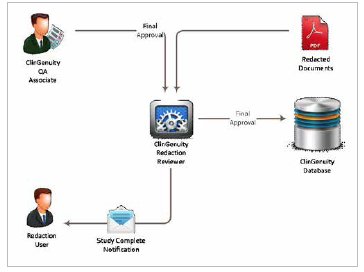 The call for transparency and disclosure of clinical trial data is growing louder. Clinical trials are essential to bringing new therapies to patients. However, the individuals who participate in those trials put themselves at risk, and it is up to the medical community to derive as much benefit from that risk as possible. Disclosing clinical trial information and creating transparency around the data is a key step toward maximizing that benefit, increasing trust between the public and the industry, providing data for further work by additional researchers that could spur new products or therapeutic approaches, and potentially avoiding unnecessary trials. Additionally, new data transparency laws have highlighted the need for new automated solutions. Data sharing carries a risk, especially with regard to the accidental disclosure of personally identifiable information, patient-protected data, and company-confidential information.
The call for transparency and disclosure of clinical trial data is growing louder. Clinical trials are essential to bringing new therapies to patients. However, the individuals who participate in those trials put themselves at risk, and it is up to the medical community to derive as much benefit from that risk as possible. Disclosing clinical trial information and creating transparency around the data is a key step toward maximizing that benefit, increasing trust between the public and the industry, providing data for further work by additional researchers that could spur new products or therapeutic approaches, and potentially avoiding unnecessary trials. Additionally, new data transparency laws have highlighted the need for new automated solutions. Data sharing carries a risk, especially with regard to the accidental disclosure of personally identifiable information, patient-protected data, and company-confidential information.
Synchrogenix’s powered by ClinGenuity Clinical Redaction Management Service (CRMS) is the only (AI) artificial intelligence-enabled automated redaction solution in the biopharmaceutical industry. Synchrogenix acquired ClinGenuity in January 2015.
The RMS removes sensitive patient and company information from clinical trial data consistently, accurately, and efficiently, enabling sponsors to meet new data transparency and disclosure regulations, such as the European Medicines Agency Policy 70, without concern.
The platform is built on natural language processing and recognition. The engine is able to identify individual words, parts of speech, word combinations, and phrasing combinations automatically and therefore can determine context.
When the European Medicines Agency (EMA) adopted Policy 70, Publication of Clinical Data for Medicinal Products for Human Use, on Jan. 1, 2015, it set the stage for a new era in data transparency and disclosure. Under this new law, EMA will publish all clinical study reports that support an approved marketing authorization. After July 1, 2015, EMA will also provide access to clinical trial data supporting additional drug indications or extensions for already approved products. In the future, EMA also plans to make available individual patient data. Policy 70 is the first key step toward a new EU Clinical Trials Regulation expected in 2016. The FDA, along with the National Institutes of Health (NIH), are also addressing the need for improved data transparency and disclosure. The 2012 FDA Safety and Innovation Act requires the agency to address that issue.
Genomic Sequencing
Regeneron is Translating Genomic Data for Real Patient Impact
Regeneron intends to build the world’s most comprehensive genotype-phenotype resource combining 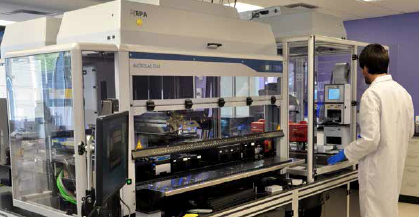 de-identified genomic and clinical data. And it is well on its way. Regeneron Genetics Center, a wholly-owned subsidiary of Regeneron Pharmaceuticals, has already sequenced the exomes of more than 25,000 volunteers in the last six months and intends to sequence more than 250,000 over five years.
de-identified genomic and clinical data. And it is well on its way. Regeneron Genetics Center, a wholly-owned subsidiary of Regeneron Pharmaceuticals, has already sequenced the exomes of more than 25,000 volunteers in the last six months and intends to sequence more than 250,000 over five years.
The Regeneron Genetics Center (RGC) was launched in January 2014 with the goal of using genetic data to inform and improve the drug development process. The RGC is working with a variety of academic, health system, and industry collaborators to combine Regeneron’s sequencing and analysis capabilities with de-identified medical records to illuminate, on a large scale, genetic factors that cause or influence a range of human diseases.
This project is one of the largest sequencing efforts in the world, and is the only program of its type that has access to diverse sets of both family- and population-based data. Through a partnership with the Geisinger Health System, the organization will focus on making genomic data medically actionable by pairing genotypic and phenotypic information. This paired information will help identify novel targets and biomarkers, validate existing drug development programs at Regeneron, and aid in more informed development of its existing and future clinical programs.
The RGC is currently sequencing at a rate of more than 50,000 individual exomes per year through its collaborations with Geisinger and other leading academic institutions.
RGC founders and Regeneron Genetics steering committee include: Dr. George Yancopoulos, M.D., Ph.D.; Aris Baras, M.D.; Aris Economides, Ph.D.; Scott Mellis, M.D., Ph.D.; Andrew Murphy, Ph.D.; Robert Phillips, Ph.D.; and Neil Stahl, Ph.D.
Standardization for Clinical Trials
ICON Instrument Library and Consent Forms Address Patient Needs
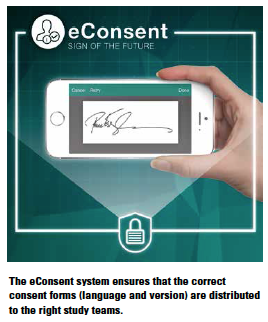 With the use of smartphone and tablet use rising among clinical trial participants, making sure patient questionnaires meet guidelines from the FDA and ISPOR has become challenging. ICON’s Patient Reported Outcome (PRO) Instrument Library, launched in 2014, addresses this challenge by providing a simplified questionnaire administration and use and sharing and re-use of electronic copies across different sponsors and devices.
With the use of smartphone and tablet use rising among clinical trial participants, making sure patient questionnaires meet guidelines from the FDA and ISPOR has become challenging. ICON’s Patient Reported Outcome (PRO) Instrument Library, launched in 2014, addresses this challenge by providing a simplified questionnaire administration and use and sharing and re-use of electronic copies across different sponsors and devices.
Another company innovation — Firecrest’s eConsent forms — helps to eliminate errors while providing a real-time view of trial compliance that are 21 CFR part 11 compliant.
Despite intensive and costly monitoring, 9% of FDA findings are due to errors in the consenting process — the third most common cause of FDA findings.
Firecrest eConsent is a cloud-based solution that eliminates paper-based patient consent processes and enables electronic capture of signatures via common Internet browsers, smartphones, or USB signature pads.
eConsent works with patient videos explaining the trial, consenting process, drug mechanism of action, and study procedures.
Interoperable Health Records for Clinical Research
Nextrials’ E2E Integrates Systems
With the average time to develop a drug ranging from 10 to 15 years, and the cost trending upward of $1.2 billion, 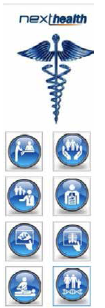 having cleaner data faster can save money and speed decision-making in clinical trials. Nextrials’ E2E is the first step toward interoperability of systems across healthcare. This software solution integrates EHR systems with EDC for clinical research, allowing researchers to extract data directly from the EHR, eliminating transcription errors, and reducing source data verification. Research sites can also enroll patients and manage data queries all from the EHR system they use every day.
having cleaner data faster can save money and speed decision-making in clinical trials. Nextrials’ E2E is the first step toward interoperability of systems across healthcare. This software solution integrates EHR systems with EDC for clinical research, allowing researchers to extract data directly from the EHR, eliminating transcription errors, and reducing source data verification. Research sites can also enroll patients and manage data queries all from the EHR system they use every day.
In 2013, the Society of Clinical Data Management awarded Nextrials with its Innovation Award for E2E.
Real-time Access to Study Data
PPD’s System Combines Data from Multiple Sources
While flicking through buttons on his TV remote control to find key football player statistics real time during a game, Niklas Morton, PPD’s VP of biostatistics programming and medical writing, was interrupted by his middle-school-aged daughter, who wanted to purchase a new book online. The website shared real-time data on the best prices and delivery timelines, based on inventories at the distribution sites, and also suggested other books she might like. This was the inspirational moment for Mr. Morton, and reinforced for him the need for such capabilities in clinical research and led to the development of Preclarus.
Preclarus, PPD’s comprehensive data portfolio solution, is more than technology — it’s the process, people, and organization behind the data. Preclarus provides a view into clinical trial data and operations by consolidating and standardizing data from multiple sources, and generating sophisticated analytics that facilitate more informed strategies and more efficient operations. It compiles both patient and metric data from CTMS, EDC, IVRS/IWRS, central lab and third-party vendor data into a data warehouse, where it can be viewed through interactive dashboards that provide visual representations of data.
Since the launch of Preclarus, the centralized site intelligence and activation group has decreased cycle times for site activation by 15%.
Using Real-World Information
Trinity Pharma Puts Real-World Data Platform on the Cloud
The promise of healthcare reform lies in the shift from volume-based to value-based care, and this will require real-word information. Trinity Pharma Solutions’ Real World Evidence (RWE) platform expands use of RWE data across the clinical-commercial continuum within the pharmaceutical industry. Cloud-enabled and mobile-ready, the solution translates RWE data into patient-centric intelligence and guided analytics for use across functional groups.
The traditional approach to solving the challenge of big data analytics involves engaging a systems integrator to custom build a large-scale, complex IT infrastructure and support it with ongoing services. These build efforts can easily require several years and tens of millions of dollars.
Trinity’s system aggregates data from numerous RWE sources, including EHRs/EMRs, insurance claims, hospital reports, clinical trials, and patient registries, etc., and allows intuitive access to information, tailored to various users, technical and non-technical alike. The platform’s patient cohort analysis tool provides a detailed understanding of very specific patient populations’ interactions with the healthcare network, treatment strategy as well as associated adherence measures, therapeutic outcomes, and cost of care.
Encouraging Behavior Change
Cognizant’s System Addresses Patient Motivations
By itself, technology cannot sustain or engage patients to effect the behavior changes needed to attain the 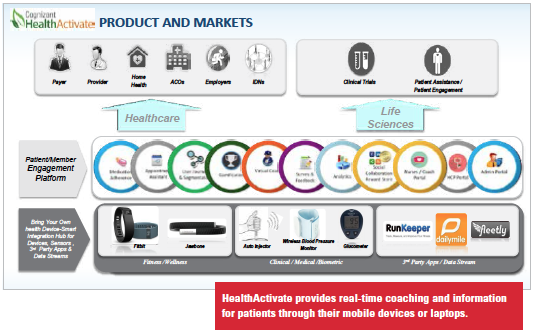 healthcare “triple aim" of reducing costs, improving outcomes, and improving patient satisfaction. There are hundreds of apps available to patients and consumers for various medical conditions, but research shows that usage of these apps drops off quickly after a few weeks and the desired behavior relapses into former noncompliant patterns.
healthcare “triple aim" of reducing costs, improving outcomes, and improving patient satisfaction. There are hundreds of apps available to patients and consumers for various medical conditions, but research shows that usage of these apps drops off quickly after a few weeks and the desired behavior relapses into former noncompliant patterns.
To address these challenges, HealthActivate from Cognizant adds two more critical components: a high-touch capability to provide personalized coaching and a gamification capability. HealthActivate provides personalized, targeted patient education and services that encourage and support the right treatment-related behaviors regarding medication, activity, and nutrition regimens, and assist the patient in understanding their condition. It also provides patients with real-time virtual coaching through their mobile devices or laptops.
Early Disease Detection
SRI Biosciences Rapidly Analyzes Blood for Diseases
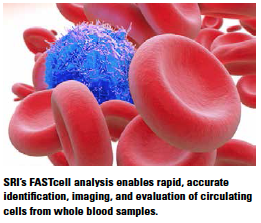 Although the observation that tumor cells were shed into the blood was first made about 100 years ago, it took the better part of a century for the idea of using a liquid biopsy, i.e., analyzing tumor cells in the blood for diagnostic and prognostic applications, to take off. A novel Fiber-optic Array Scanning Technology (FAST) cytometer is at the heart of the SRI Biosciences FASTcell assay platform. The breakthrough moment for the technology came at Xerox subsidiary PARC, when researchers realized that laser scanning devices similar to those used for Xerox reproductions could be applied to the high-resolution detection of rare cells.
Although the observation that tumor cells were shed into the blood was first made about 100 years ago, it took the better part of a century for the idea of using a liquid biopsy, i.e., analyzing tumor cells in the blood for diagnostic and prognostic applications, to take off. A novel Fiber-optic Array Scanning Technology (FAST) cytometer is at the heart of the SRI Biosciences FASTcell assay platform. The breakthrough moment for the technology came at Xerox subsidiary PARC, when researchers realized that laser scanning devices similar to those used for Xerox reproductions could be applied to the high-resolution detection of rare cells.
They went on to develop the FAST scanner, which can scan 20 million cells per minute to detect a signal abnormal one, in this case a circulating tumor cell (CTC). It enables high-definition, detailed imaging of individual CTCs in blood and downstream analysis that provides information about biomarkers that are critical to patient prognosis and potential response to cancer therapies.
The potential uses for FASTcell are far reaching, and include enhanced cancer treatments, stem cell research, and cardiovascular-disease diagnosis and treatment.
Targeting Physicians
CMI/Compas Tool Delivers Targeted Messaging
It’s not just about knowing that cardiologists need to get a message; more important is knowing that Dr. Bob Case, cardiologist, needs to get this message. Dr. Bob Case is a cardiologist who also likes sports. He also subscribes to the weekly e-newsletter from the New England Journal of Medicine. While he logs online to check out the highlights from the Knicks’ game last night, he is served an ad that is relevant to him, at a time that he is available to read its content.
CMI/Compas’ AdMission can deliver ads to target physicians when and where they are online. It is a programmatic buying active platform to consistently reach and deliver messages to target healthcare providers in their daily digital environment maximizing the effectiveness of a pharmaceutical brand’s advertising or promotional campaign.
The platform works together with CMI/Compas’ ByDoctor technology, an HCP-level multichannel promotional access, to increase control of campaign performance and deliver enhanced targeting capabilities.
AdMission can increase accountability of the campaign by eliminating wasted promotional spend, providing transparency and enhancing ad verification.
Sales Solutions
IMS Health Solution Delivers Just-in-Time Insights
While the use of nonpersonal channels is on the rise, the sales channel remains the strongest lever for influencing customer behavior. Ultimately, both personal and nonpersonal approaches are critical to improving brand performance; in fact, all marketing and sales efforts should be customer-focused and aligned from strategy through execution.
IMS Health’s Mobile Sales is reported to be the first mobile sales and marketing effectiveness solution that allows life-sciences companies to optimize and execute brand strategies at the local level. The system uses IMS Health’s patent-pending Next Best Customer methodology, which helps prioritize customers based on brand strategy, local dynamics, and multiple data sources, including targeted prescriber behavior, payer influence, territory sales, and proximity.
Mobile Sales promotes a strategic, analytics-first approach to customer engagement and it embeds strategically aligned territory analytics into each sales representative’s territory management by delivering just-in-time, locally relevant insights to their tablets. It provides automated alerts about customer trends, payer opportunities, and gaps in execution for each specific territory, eliminating the need for sales teams to translate national strategy, review disparate data, or run queries or reports.
Cloud Platform Enables a New Commercial Model
Veeva Commercial Cloud Brings Together Interactions, Content, and Data
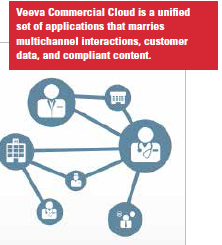 The emergence of cloud computing ushered in a new wave of information technology that is more flexible than anything in the past. Yet, many of the world’s largest industries have been unable to take advantage of the cloud in key areas. They require highly specialized solutions to address critical business functions and regulations, and have been stuck on legacy solutions because a generic, horizontal cloud is not a fit.
The emergence of cloud computing ushered in a new wave of information technology that is more flexible than anything in the past. Yet, many of the world’s largest industries have been unable to take advantage of the cloud in key areas. They require highly specialized solutions to address critical business functions and regulations, and have been stuck on legacy solutions because a generic, horizontal cloud is not a fit.
Veeva Commercial Cloud is a unified set of applications that marries multichannel interactions, customer data, and compliant content. Veeva Commercial Cloud replaces a host of disparate systems with one, easily accessible, cloud-based system for all customer data and activity across channels, geographies, and customer types.
Bringing together interactions, content, and data, Veeva Commercial cloud is enabling life-sciences companies to evolve to a new commercial model, and move from just face-to-face visits with doctors to anytime, anywhere engagement with a broader set of stakeholders.
Site Monitoring
CluePoints’ Cloud-based CSM Solution
Until recently, clinical site monitoring has almost exclusively been carried out via routine site visits every four to  eight weeks, using 100% source data verification. This antiquated process can account for more than 30% of a pharmaceutical sponsor’s overall costs (equating to tens of millions of dollars), while resulting in less than 3% post-visit data changes, a high price to pay for little gain.
eight weeks, using 100% source data verification. This antiquated process can account for more than 30% of a pharmaceutical sponsor’s overall costs (equating to tens of millions of dollars), while resulting in less than 3% post-visit data changes, a high price to pay for little gain.
In 2014, CluePoints broke new ground with the launch of a solution that allows customers to drive their own analyses through a new Web platform. The first-of-its-kind cloud-based architecture was developed to give sponsors and CROs full control of risk-based monitoring (RBM).
As budgets become more difficult to manage and data issues grow, regulatory authorities and most in the industry no longer believe that the traditional approach to site monitoring represents the best option.
CluePoints’ solution enables a large number of statistical tests to be carried out in a single engine, including the automatic pre-processing data, advanced statistical models, and automated scoring. This enables a much more powerful analysis of study data than any group of individuals could achieve, detecting anomalies that otherwise could be missed and considerably improving patient safety.
CluePoints’ platform received a 2014 Scrip Award for Best Technological Development in Clinical Trials, an ENTENTE Life Science Investment Forum Award 2014, and a European Venture Contest Award 2014.
CluePoints is in the process of being commissioned by the FDA to build a version of the statistical engine to select sites for audit from data submitted for approval. This is a huge endorsement of the approach in leaving no stone unturned in assessing the quality and integrity of the trial data and ensuring the safety of all patients.
Sample Management System
PharmaCommunications Systems Offers SaaS
 Sample and promotional material distribution services to pharmaceutical sales teams have traditionally occurred in-house or have been provided by marketing services suppliers, such as mailing and fulfillment houses. Both processes require the use, and the integration, of multiple software programs to deal with complexities of managing samples and promotional materials in the industry.
Sample and promotional material distribution services to pharmaceutical sales teams have traditionally occurred in-house or have been provided by marketing services suppliers, such as mailing and fulfillment houses. Both processes require the use, and the integration, of multiple software programs to deal with complexities of managing samples and promotional materials in the industry.
Pharmaceutical and biotechnology marketing departments develop sampling and promotional material budgets on financial software, and track the development of promotional materials on promotional mapping software.
Salesforces place orders on internal ordering systems, or CRM systems, or a combination of both. Finance departments manage sample and promotional material budgets through their accounting system. Internal or third-party distribution centers manage inventory and distribution logistics through warehouse management systems. Additionally, sales, marketing, and finance teams track results on analytics software.
PharmaCommunications Systems’ PharmaSalesSupport.com was developed in response to the lack of a fully integrated SaaS solution to deal with the unique requirements of managing the needs of pharmaceutical sales teams with respect to samples and promotional materials.
From approval management, to quota setting, to ordering, tracking, and inventory control,
PharmaSalesSupport.com provides a complete turnkey solution that maximizes opportunity and minimizes administrative headaches.
The greater efficiency of completing these tasks benefits pharmaceutical manufacturers, which ultimately benefits their customers.
PharmaSalesSupport.com is currently in its launch phase.
Outsourced Sales Alternative
Publicis Touchpoint Provides Options for Smaller Companies
Historically, most biopharmaceutical manufacturers that used an outsourced provider to manage their field-based teams chose to bundle both the personnel functions and the commercial effectiveness functions into one outsourcing project. But smaller or emerging companies, while not prepared for an in-house salesforce, may still want some ownership of the sales team.
Publicis Touchpoint Solution’s Commercial Effectiveness as a Service (CEaaS) is an alternative to traditional all-or-nothing field-force outsourcing. With CEaaS, clients that choose to maintain “ownership" of their field teams (hiring, training, managing) can outsource the technology-intensive commercial effectiveness functions, including targeting/alignment, SFA/CRM, fleet management, sample management, data integration/warehousing, reporting, expense tracking, and sales/incentive compensation.
CEaaS can improve the well-being of field representatives by providing cutting-edge tools that reduce downtime and increase both efficiency and time with customers. Finally, and most importantly, it can extend and improve the lives of patients by helping clients be more effective and efficient in presenting their life-saving products to key healthcare stakeholders. (PV)
launch phase.Outsourced Sales Alternative
Publicis Touchpoint Provides Options for Smaller Companies
Historically, most biopharmaceutical manufacturers that used an outsourced provider to manage their field-based teams chose to bundle both the personnel functions and the commercial effectiveness functions into one outsourcing project. But smaller or emerging companies, while not prepared for an in-house salesforce, may still want some ownership of the sales team.
Publicis Touchpoint Solution’s Commercial Effectiveness as a Service (CEaaS) is an alternative to traditional all-or-nothing field-force outsourcing. With CEaaS, clients that choose to maintain “ownership" of their field teams (hiring, training, managing) can outsource the technology-intensive commercial effectiveness functions, including targeting/alignment, SFA/CRM, fleet management, sample management, data integration/warehousing, reporting, expense tracking, and sales/incentive compensation.
CEaaS can improve the well-being of field representatives by providing cutting-edge tools that reduce downtime and increase both efficiency and time with customers. Finally, and most importantly, it can extend and improve the lives of patients by helping clients be more effective and efficient in presenting their life-saving products to key healthcare stakeholders. (PV)


















